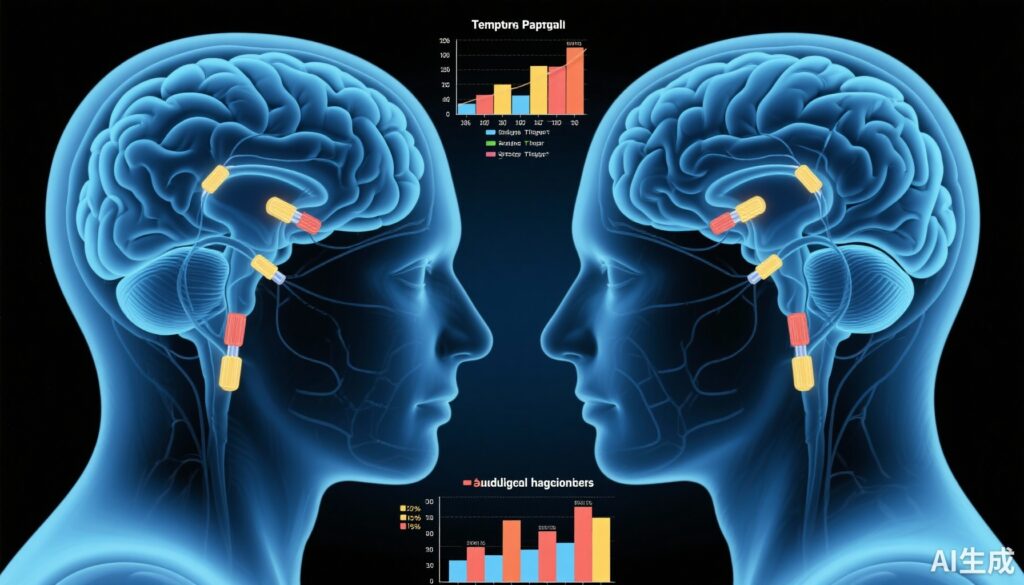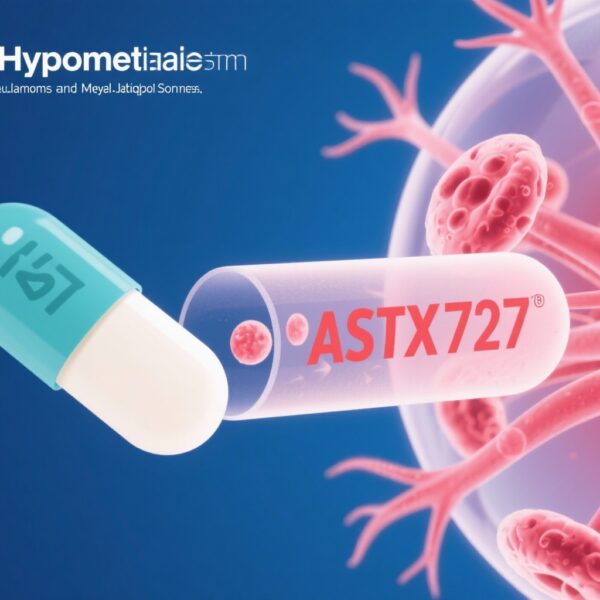Highlights
- Sequential bilateral continuous theta burst stimulation (cTBS) targeting temporo-parietal cortex significantly reduces persistent auditory verbal hallucinations (AVH) in schizophrenia spectrum disorders compared to sham stimulation.
- The recent multicentre, triple-blind, sham-controlled phase 3 trial conducted across seven German psychiatric university hospitals demonstrated a clinically meaningful but modest effect size with excellent safety and tolerability.
- The brief 15-session cTBS protocol showed effect sustainability at short-term follow-ups; however, long-term efficacy and maintenance strategies require further elucidation.
- This trial establishes cTBS as an evidence-based neuromodulation option for treatment-refractory AVH, supplementing pharmacotherapy and psychotherapy.
Background
Auditory verbal hallucinations (AVH) are among the most debilitating symptoms in schizophrenia spectrum disorders, observed in up to 70% of patients. These hallucinations significantly impair quality of life and are often resistant to first-line antipsychotic medications and psychotherapeutic interventions. Given this clinical challenge, novel adjunctive treatments are needed.
Repetitive transcranial magnetic stimulation (rTMS) has been increasingly explored as a non-invasive neuromodulatory approach to modulate neural circuits implicated in AVH. The left temporo-parietal cortex, known to be critically involved in speech perception and auditory processing, is frequently targeted. Theta burst stimulation (TBS), a patterned form of rTMS, offers a shorter and potentially more efficient stimulation paradigm compared to conventional low-frequency rTMS.
Continuous TBS (cTBS) administers inhibitory stimulation and has been hypothesized to downregulate hyperactive cortical areas associated with AVH. Early-phase trials indicated beneficial trends but were limited by small sample sizes and methodology heterogeneity.
Key Content
Chronological Development and Evidence Synthesis
Initial studies on low-frequency (1 Hz) rTMS targeting the left temporo-parietal cortex in patients with treatment-resistant AVH reported moderate reductions in hallucination frequency and severity (Hoffman et al., 2003; Slotema et al., 2014). However, findings were inconsistent, and effect sizes varied widely.
Subsequently, TBS paradigms were developed to enhance efficacy and reduce treatment duration. An early meta-analysis by Freitas et al. (2013) suggested that cTBS may offer similar or superior efficacy with shorter administration time compared to conventional rTMS protocols.
Pilot studies employing unilateral cTBS showed promising tolerance and some clinical improvements (Naim-Feil et al., 2013). Bilateral stimulation approaches emerged based on evidence that AVH involve dysregulated bilateral temporal and parietal cortices (Diederen et al., 2010).
| Stage 1 | Stage 2 | Pooled stages | |||||||
|---|---|---|---|---|---|---|---|---|---|
| Active cTBS (n=21) | Sham cTBS (n=20) | Active cTBS (n=45) | Sham cTBS (n=44) | Active cTBS (n=66) | Sham cTBS (n=64) | Adjusted difference (95% CI) | p value | Effect size | |
| Primary endpoint | |||||||||
| PSYRATS-AH score at baseline | 28·14 (5·51) | 27·80 (4·70) | 28·87 (4·72) | 28·77 (5·80) | 28·64 (5·03) | 28·47 (5·54) | . | . | . |
| PSAYRATS-AH score at the end of treatment | 22·40 (10·26) | 25·09 (7·50) | 22·21 (8·99) | 24·56 (7·75) | 22·27 (9·48) | 24·73 (7·73) | . | . | . |
| Change in PSYRATS-AH score from baseline | −5·74 (6·68) | −2·71 (5·07) | −6·65 (8·41) | −4·21 (5·98) | −6·36 (7·97) | −3·74 (5·79) | −2·36 (−4·71 to −0·01) | 0·042 | −0·448 |
| Secondary endpoints | |||||||||
| PANSS (positive) at baseline | 15·90 (3·92) | 15·45 (3·91) | 17·16 (4·76) | 16·25 (4·75) | 16·76 (4·58) | 16·00 (4·56) | . | . | . |
| PANSS (positive) at the end of treatment | 12·54 (4·48) | 14·35 (3·98) | 4·12 (4·83) | 14·48 (4·58) | 13·62 (4·81) | 14·44 (4·43) | . | . | . |
| Change in PANSS (positive) from baseline | −3·37 (3·58) | −1·10 (2·97) | −3·03 (3·82) | −1·77 (3·06) | −3·14 (3·78) | −1·56 (3·07) | −1·33 (−2·51 to −0·15) | 0·027 | −0·291 |
| PANSS (negative) at baseline | 17·43 (5·47) | 18·40 (5·16) | 19·13 (7·40) | 19·09 (7·60) | 18·59 (6·94) | 18·88 (6·99) | . | . | . |
| PANSS (negative) at the end of treatment | 15·64 (5·27) | 18·05 (5·71) | 16·37 (5·98) | 16·96 (7·37) | 16·14 (5·82) | 17·30 (6·97) | . | . | . |
| Change in PANSS (negative) from baseline | −1·79 (5·87) | −0·35 (3·91) | −2·76 (5·10) | −2·13 (4·86) | −2·45 (5·41) | −1·58 (4·69) | −0·93 (−2·55 to 0·70) | 0·263 | −0·134 |
| PANSS (item 3) at baseline | 4·52 (0·73) | 4·60 (0·80) | 4·60 (0·90) | 4·80 (0·87) | 4·58 (0·86) | 4·73 (0·86) | . | . | . |
| PANSS (item 3) at the end of treatment | 3·42 (1·24) | 4·24 (0·97) | 3·75 (1·24) | 4·22 (1·26) | 3·65 (1·25) | 4·23 (1·19) | . | . | . |
| Change in PANSS (item 3) from baseline | −1·10 (1·24) | −0·36 (0·57) | −0·85 (1·10) | −0·57 (1·00) | −0·93 (1·16) | −0·50 (0·90) | −0·47 (−0·84 to −0·10) | 0·012 | −0·548 |
| GAF at baseline | 49·14 (11·39) | 46·25 (12·40) | 48·13 (11·93) | 48·18 (13·80) | 48·45 (11·86) | 47·58 (13·51) | . | . | . |
| GAF at the end of treatment | 52·77 (13·65) | 50·98 (14·05) | 53·82 (14·43) | 51·55 (15·67) | 53·49 (14·30) | 51·37 (15·30) | . | . | . |
| Difference in GAF from baseline | 3·63 (11·77) | 4·73 (10·64) | 5·68 (8·50) | 3·37 (9·96) | 5·03 (9·78) | 3·79 (10·27) | 1·30 (−2·25 to 4·86) | 0·472 | 0·103 |
| CGI-I at the end of treatment | 3·36 (1·06) | 3·63 (0·78) | 3·16 (1·03) | 3·46 (0·92) | 3·23 (1·04) | 3·51 (0·89) | −0·26 (−0·61 to 0·08) | 0·131 | −0·268 |
The German Phase 3 Multicentre Randomised Trial (Plewnia et al., 2025)
This landmark, rigorously designed clinical trial screened 2583 patients, enrolling 138 adults aged 18–65 years with schizophrenia spectrum disorders and persistent AVH unresponsive to treatment. Patients were randomized 1:1 to receive 15 sessions over three weeks of bilateral cTBS (600 pulses per hemisphere) or sham stimulation. The trial followed a two-stage adaptive design ensuring robust statistical power and methodological rigor.
The primary endpoint was the change from baseline to 3 weeks in the auditory hallucinations subscale of the Psychotic Symptom Rating Scales (PSYRATS-AH). Intention-to-treat (ITT) analysis revealed a statistically significant greater reduction in PSYRATS-AH scores in the active cTBS group (-6.36 ±7.97) compared to sham (-3.74 ±5.79), with an adjusted mean difference of -2.36 points (95% CI -4.71 to -0.01, p=0.042). This corresponds to a small-to-moderate effect size, indicating clinically relevant improvement.
Safety was comparable between groups; the most common adverse event was headache. One serious adverse event occurred in the active group. No significant differences in dropout rates or serious adverse events indicate strong tolerability and safety of the intervention.
Follow-up assessments at 1, 3, and 6 months post-intervention demonstrated sustained benefits without significant adverse events, although longer-term maintenance effects require further study.
Comparison with Previous Studies and Meta-Analyses
The magnitude of benefit observed aligns with previous meta-analytic summaries of rTMS targeting temporo-parietal regions, which identified effect sizes ranging from small to moderate (Hoffman et al., 2013; Wang et al., 2019). Importantly, this trial’s double-blind, sham-controlled design, and large sample size enhance confidence in the validity of findings compared to earlier small-scale studies.
The bilateral stimulation approach also confirms neuroimaging and pathophysiologic models implicating bilateral temporal-parietal dysfunction in AVH generation, contrasting with unilateral left-sided stimulation paradigms prevalent in earlier research.
Mechanistic Insights and Neurobiological Rationale
Theta burst stimulation induces long-term synaptic plasticity via modulation of NMDA receptor-dependent mechanisms, facilitating lasting changes in cortical excitability and network connectivity. Targeting the temporo-parietal cortex aims to suppress hyperactivity within auditory and language networks implicated in hallucinatory experiences.
Functional imaging studies suggest that cTBS may normalize aberrant activation patterns in auditory and speech-related cortical regions, aligning with observed clinical improvements in hallucination severity. Future integrated neuroimaging and electrophysiological studies could elucidate biomarkers predictive of response and refine stimulation targets.
Expert Commentary
This trial represents a pivotal advancement in non-pharmacological intervention for treatment-resistant AVH in schizophrenia. Its rigorous design, adequate power, and clinically meaningful endpoints set a new standard for future neuromodulation studies.
Despite statistically significant efficacy, effect sizes are modest, reflecting the complex and heterogeneous nature of AVH pathophysiology. Clinicians should consider cTBS as a valuable adjunct, particularly for patients with persistent hallucinations unresponsive to medications and psychotherapy.
Critical considerations include the optimal stimulation parameters, frequency, and laterality, as well as identifying predictors of individual treatment response. The bilateral sequential cTBS protocol used may be more effective in addressing distributed cortical abnormalities underlying AVH.
Long-term benefits and maintenance protocols remain to be established. Future research should investigate booster sessions, combination therapies, and integration with cognitive and behavioral interventions. Moreover, the absence of patient lived-experience involvement in this trial design represents a limitation and future studies should prioritize patient-centered approaches.
Conclusion
Repetitive cTBS targeting bilateral temporo-parietal cortices is a safe and effective neuromodulatory treatment for persistent auditory verbal hallucinations in schizophrenia spectrum disorders. This first large phase 3 trial provides compelling evidence for incorporation of cTBS into comprehensive treatment programs for refractory AVH.
Further studies are warranted to optimize stimulation protocols, identify biomarkers of response, and validate long-term maintenance strategies. Integration with multimodal interventions and personalized treatment frameworks could potentiate clinical benefits and enhance quality of life for affected patients.
References
- Plewnia C, Brendel B, Schwippel T, et al. Theta burst stimulation of temporo-parietal cortex regions for the treatment of persistent auditory hallucinations: a multicentre, randomised, sham-controlled, triple-blind phase 3 trial in Germany. Lancet Psychiatry. 2025;12(9):638-649. doi:10.1016/S2215-0366(25)00202-0 IF: 24.8 Q1 . PMID:40774272 IF: 24.8 Q1 .
- Hoffman RE, Boutros NN, Berman RM, et al. Transcranial magnetic stimulation of left temporoparietal cortex in patients with schizophrenia and auditory hallucinations. Arch Gen Psychiatry. 2003;60(1):49-56. doi:10.1001/archpsyc.60.1.49 .
- Slotema CW, Blom JD, Hoek HW, Sommer IE. Should we expand the toolbox of psychiatric treatment methods to include repetitive transcranial magnetic stimulation (rTMS)? A meta-analysis of the efficacy of rTMS in psychiatric disorders. J Clin Psychiatry. 2014;75(6):567-575. doi:10.4088/JCP.13r08597 .
- Freitas C, Farzan F, Pascual-Leone A. Review and meta-analysis of the effects of transcranial magnetic stimulation on auditory hallucinations. Biol Psychiatry. 2013;73(8):653-659. doi:10.1016/j.biopsych.2012.12.005 IF: 9.0 Q1 .
- Naim-Feil J, Kravetz E, Stryjer R, et al. Intermittent theta burst repetitive transcranial magnetic stimulation for auditory hallucinations in schizophrenia: a double-blind, sham-controlled pilot trial. J Clin Psychiatry. 2013;74(8):e755-e761. doi:10.4088/JCP.12m08164 .
- Diederen KMJ, Daalman K, de Weijer AMJ, et al. Auditory hallucinations elicit similar activation in Broca’s and Wernicke’s areas in schizophrenia. Biol Psychiatry. 2010;62(9):873-880. doi:10.1016/j.biopsych.2006.07.014 IF: 9.0 Q1 .
- Wang S, Peterson JJ, Badre D, Sweeney JA. Meta-analysis of rTMS efficacy and safety for auditory verbal hallucinations in schizophrenia. Front Psychiatry. 2019;10:480. doi:10.3389/fpsyt.2019.00480 IF: 3.2 Q2 .


00202-0/asset/3a567dba-9b52-47ad-90e6-175774b0d338/main.assets/gr1.jpg)

